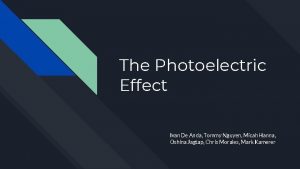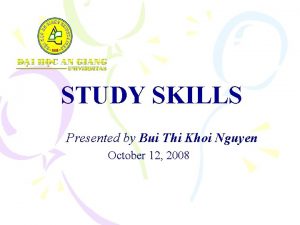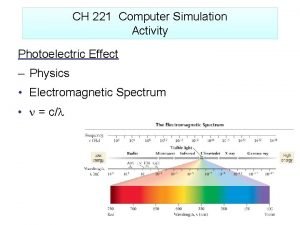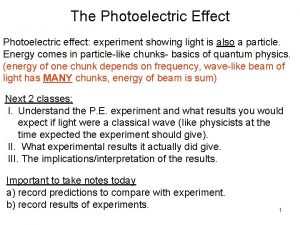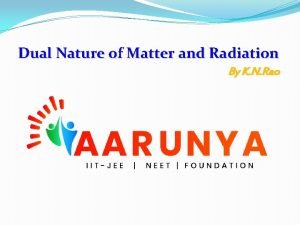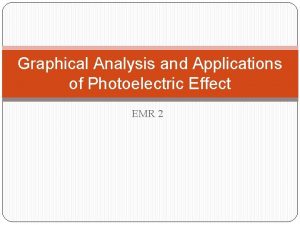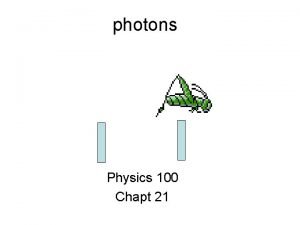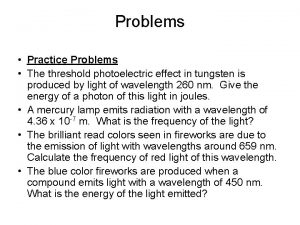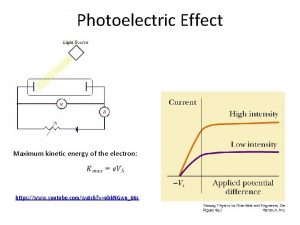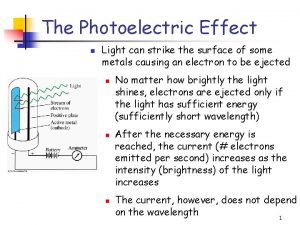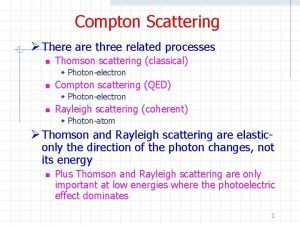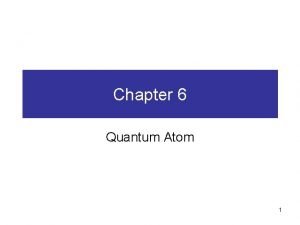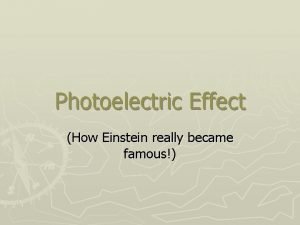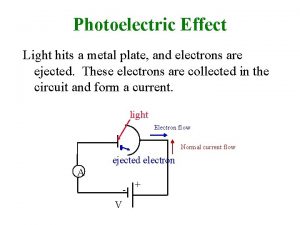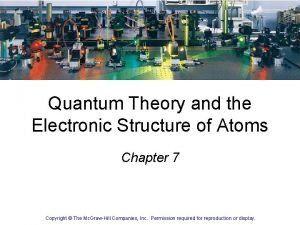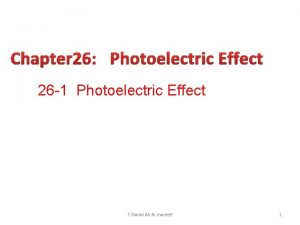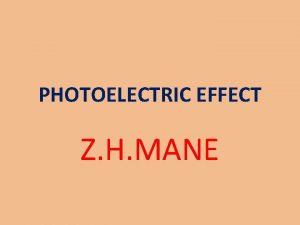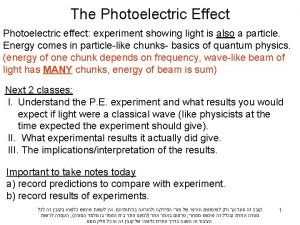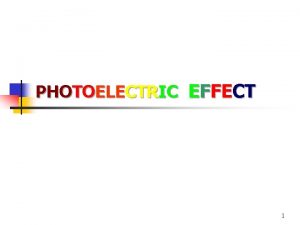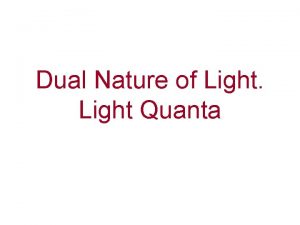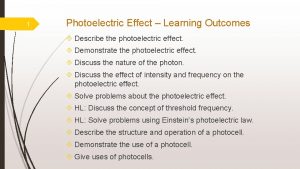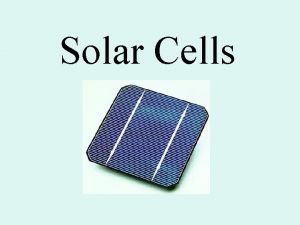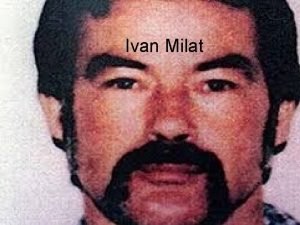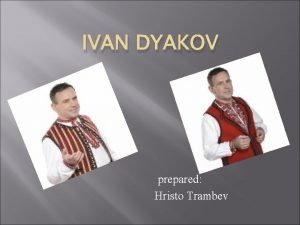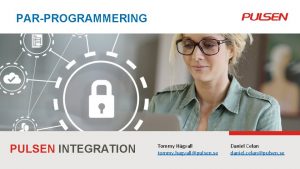The Photoelectric Effect Ivan De Anda Tommy Nguyen
















- Slides: 16

The Photoelectric Effect Ivan De Anda, Tommy Nguyen, Micah Hanna, Oshina Jagtap, Chris Morales, Mark Kamerer

Introduction to light: Waves or Particles? Light viewed as particles Isaac Newton: • • • while Corpuscular theory Wrote Optiks Accepted view for a Christiaan Huygens claims light is a wave: • Wrote The Wave Theory of Light • Accepted over Newton because of Thomas Young’s double slit experiment

A challenge to the Wave Theory of Light: The Photoelectric Effect

The Classical Photoelectric Effect: Heinrich Hertz 1887 Heinrich Hertz discovered the photoelectric effect. ● ● ● Spark gap experiment to prove Maxwell’s equations Encasing the spark gap in container (eliminating incident UV light) decreased spark length. Refused to make theory from the results.

The Classical Photoelectric Effect: Phillip Leonard 1902 Phillip Leonard; assistant to Heinrich Hertz ● ● ● Experimented using a prism (right) velocity of the ejected electrons were independent of the intensity of light Electron energy increase with frequency of incident light His studies led to the addition of the Photoelectric effect being added to the list of ways that an electron can be emitted. Sharing space with Thermionic emission, Secondary emission, and Field emission.

How It’s Made: classical results Experiment used to detect photons. Five major points: https: //images. app. goo. gl/zr 2 KNEHedg. Nt. FAjs 6

Summary of classical experiment

The Man, The Myth, The Legend Albert Einstein comes into this when he took interest in Planck’s hypothesis, the electromagnetic field is quantized. He wrote in “Annalen der Physik” which is the oldest scientific journal from the 1970’s. What he proposed was that the light particles behave as both waves and particles. [9]

Modern Interpretation: Photoelectric Effect Revisited Einstein started his dive into the Photoelectric effect by stating that the energy quantum of a photon is: E = hf These photons need to overcome the work of the material and the resulting energy is what the electrons have as they escape. This is represented by E = Φ + K = hf Now we can represent the energy (e. V) of these photons by the function hf = Φ + ½ mv^2

Modern Interpretation: Photons The modern interpretation follows Einstein’s findings regarding wave-particle duality where the light behaves in both ways. It also follows Planck’s quantum wave packet theory, and we use Einstein’s energy formula for wave packets Energy (photon) = hf This formula also allows us to determine the energy with the wavelength of the photons by replacing the frequency with f= c/λ

Modern Interpretation: Experimental Results Needs a threshold frequency (f₀) to begin electron ejection Higher frequency above threshold increases electron kinetic energy More light intensity (greater than f₀) increases the amount of ejected electrons [7] https: //chem. libretexts. org/Bookshelves/Physical_and_Theoretical_Chemistry_Textbook_M aps/Book%3 A_Quantum_States_of_Atoms_and_Molecules_(Zielinksi_et_al. )/02. _Foundati ons_of_Quantum_Mechanics/2. 2%3 A_Photoelectric_Effect

Modern Interpretation: Other Experimental Confirmation Then along came Robert Millikan who was determined to prove Einstein’s conclusions wrong but… in 1916 his experiment not only confirmed the photoelectric effect and Einstein’s findings, but also was able to determine Planck’s constant to be h = 4. 1 x 10⁻¹⁵ e. V s His experiment involved a light of different frequencies on a sodium electrode and measured the Kinetic energy hoping to find a nonlinear relationship. However it was linear and the slope was indeed planck’s constant. [12]

Applications of the Photoelectric Effect: Diodes Photodiodes ● ● ● Light shone at reverse bias diode. Made out of compound semiconductor (gallium and arsenide) Memory, signal processing, transmission Solar Cell ● ● Light shone at forward bias diode Cause flow of electrons Light Emitting Diode ● Recombination causes emittance of light

Futurology The photoelectric effect has to be considered in space travel. • Space shuttles are subject to discharge because of the sun’s rays • Ongoing Questions: Martian atmosphere is thinner, more sunlight reaches the ground. How would this affect metals in mars? Moon?

References 1. Hawkins, Stephen. A stubbornly persistent illusion: the essential scientific works of Albert Einstein. Philadelphia, Running Press Book Publishers, 2007 2. Newton, Isaac. Opticks, Translated by Bernard Cohen, New York, Dover Publications Inc, 1952 3. Huygens, Christiaan. Silvanus P. Thompson. Treatise on Light: In which are Explained the Causes of that which Occurs in Reflexion & in Refraction, and Particularly in the Strange Refraction of Iceland Crystal. Dover Publications, New York, 1962. 4. Hertz, Heinrich Rudolf. Miscellaneous Papers. with an Introduction by. P. Lenard. Authorized English Translation by D. E. Jones and G. A. Schott. , 1896. 5. Hertz, Heinrich. Untersuchungen u ber die Ausbreitung der elektrischen Kraft; Electric Waves, Being Researches on the Propagation of Electric Action with Finite Velocity through Space. New York: Dover Publications, 1962. Print. 6. Fowler, Michael. “The Photoelectric Effect. ” Photoelectric Effect, galileo. phys. virginia. edu/classes/252/photoelectric_effect. html. 7. Thornton, Stephen. Rex, Andrew. Modern Physics For Scientists and Engineers. Fourth Edition. Cengage Learning, 2006. 8. Wheaton, Bruce R. " Philipp Lenard and the Photoelectric Effect, 1889 -1911. " Historical Studies in the Physical Sciences, vol. 9, 1978, pp. 299 -322. 9. Annalen Der Physik (1900: Online). Leipzig: [J. A. Barth], 1900. Print. 10. Sedra, Adel. Smith, Kenneth. Microelectronic Circuits. Seventh Edition. New York, Oxford University Press, 2014. 11. Encyclopedia Britannica, “Photoelectric Effect. ” Encyclopedia Britannica, Inc. , 19 Jan. 2018, www. britannica. com/science/photoelectric-effect. 12. Millikan, Robert. “A Direct Photoelectric Determination of Planck' s ' h' " . vol. 2, , 2004.

Questions and Answers
 Tommy nguyen oxford
Tommy nguyen oxford Số nguyên tố là gì
Số nguyên tố là gì Penggalan surat lamaran pekerjaan tersebut berisi
Penggalan surat lamaran pekerjaan tersebut berisi Khoi nguyen education group
Khoi nguyen education group Photoelectric effect simulation
Photoelectric effect simulation Apitlight
Apitlight Laws of photoelectric emission
Laws of photoelectric emission Kcvs.ca photoelectric effect
Kcvs.ca photoelectric effect Photoelectric effect
Photoelectric effect Photoelectric effect practice problems
Photoelectric effect practice problems Photoelectric and compton effect
Photoelectric and compton effect Rydberg formula
Rydberg formula Photon cross section
Photon cross section Photoelectric effect
Photoelectric effect Kumar is producing the photoelectric effect by using
Kumar is producing the photoelectric effect by using Graph for photoelectric effect
Graph for photoelectric effect Photoelectric effect
Photoelectric effect
